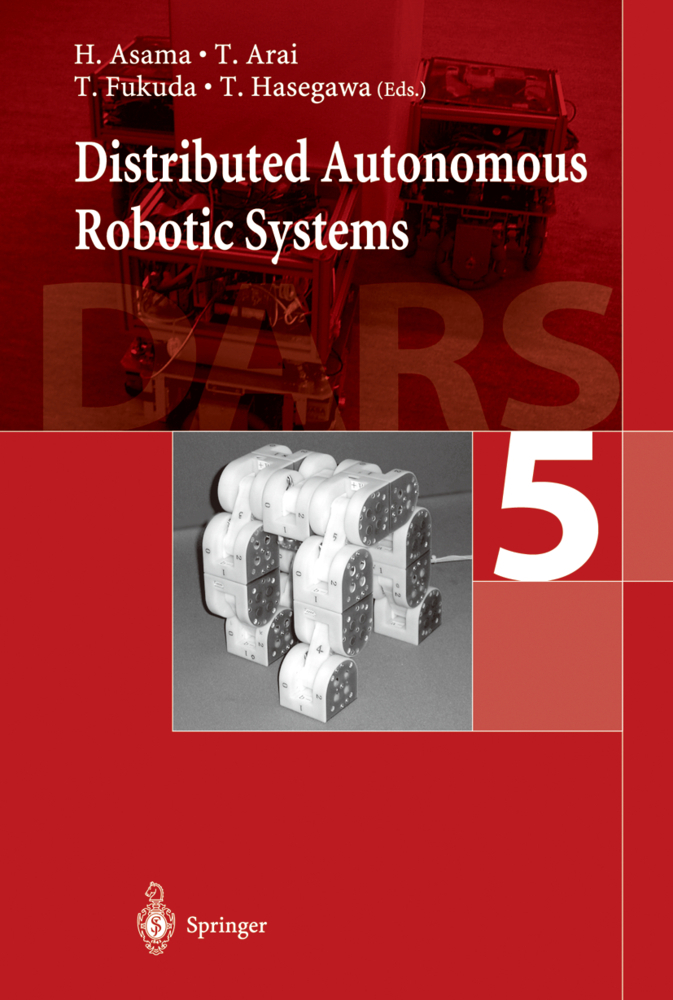
Hardcover
CHF 78.90
Innert 16 Tagen geliefert Bestpreis-Garantie Versandkostenfrei 40 Tage Rückgaberecht

Hardcover
CHF 78.90
Innert 16 Tagen geliefert Bestpreis-Garantie Versandkostenfrei 40 Tage Rückgaberecht
1: Introduction.- Perspective of Distributed Autonomous Robotic Systems.- 2: Modular Robotic Systems.- Navigating Modular Robots in the Face of Heuristic Depressions.- A Self-Reconfigurable Modular Robot (MTRAN) - Hardware and Motion Planning Software.- Automatic Parameter Identification for Rapid Setting Up of Distributed Modular Robots.- Distributed Replication Algorithms for Self-Reconfiguring Modular Robots.- 3: Communication and Cooperation.- Communication Mechanism in a Distributed System of Mobile Robots.- A Geometric Arbiter Selection Algorithm on Infrared Wireless Inter-Robot Communication.- A Study of Communication Emergence Among Mobile Robots: Simulations of Intention Transmission.- Communication by Datagram Circulation Among Multiple Autonomous Soccer Robots.- Autonomous Robots Sharing a Charging Station with No Communication: A Case Study.- 4: Human-Machine Cooperative Interaction.- A Scalable Command and Control System for Human-Machine Work Systems.- Implementing a Face Detection System Practically Robust Against Size Variation and Brightness Fluctuation for Distributed Autonomous Human Supporting Robotic Environment.- Voice Communication in Performing a Cooperative Task with a Robot.- 5: Multi-Robot Coordination.- Position Control of Load by Traction of Two Mobile Robots.- Cooperative Motion Coordination Amidst Dynamic Obstacles.- Collision Avoidance Algorithm for Two Tracked Mobile Robots Transporting a Single Object in Coordination Based on Function Allocation Concept.- A Decentralized Test Algorithm for Object Closure by Multiple Cooperating Mobile Robots.- Coordinated Transportation of a Single Object by a Group of Nonholonomic Mobile Robots.- 6: Robot Soccer.- Coordinated Trajectory Planning and Formation Control of Soccer Robots to Pass a BallCyclically.- M-ROSE: A Multi Robot Simulation Environment for Learning Cooperative Behavior.- Real-Time Adaptive Learning from Observation for RoboCup Soccer Agents.- An Empirical Study of Coaching.- 7: Distributed Control.- Decentralized Control of Redundant Manipulator Based on the Analogy of Heat and Wave Equations.- Cooperating Cleaning Robots.- Movement Model of Multiple Mobile Robots Based on Servo System.- On-Line Collision Avoidance of Mobile Robot for Dynamically Moving Obstacles.- Distributed Multi Robot Reactive Navigation.- 8: Distributed Sensing and Mapping.- Omnidirectional Distributed Vision for Multi-Robot Mapping.- How Many Robots? Group Size and Efficiency in Collective Search Tasks.- Mobile Sensor Network Deployment Using Potential Fields: A Distributed, Scalable Solution to the Area Coverage Problem.- Map Acquisition in Multi-Robot Systems Based on Time Shared Scheduling.- Principled Monitoring of Distributed Agents for Detection of Coordination Failure.- 9: Multi-Agent and Group Systems.- Cooperative Behavior of Interacting Simple Robots in a Clockface Arranged Foraging Field.- Graduated Spatial Pattern Formation of Micro Robot Group.- Heterogeneous Agents Cooperating: Robots, Field Devices, and Process Automation Integrated with Agent Technology.- 10: Multi-Robot Motion Planning.- Heuristic Approach of a Distributed Autonomous Guidance System to Adapt to the Dynamic Environment.- Spreading Out: A Local Approach to Multi-Robot Coverage.- Real-Time Cooperative Exploration by Reaction-Diffusion Equation on a Graph.- Research on Cooperative Capture by Multiple Mobile Robots - A Proposition of Cooperative Capture Strategies in the Pursuit Problem -.- 11: Emergence in Mobility.- Interpreting Two Psychological Functions by a Hierarchically StructuredNeural Memory Model.- Neural Control of Quadruped Robot for Autonomous Walking on Soft Terrain.- Kilorobot Search and Rescue Using an Immunologically Inspired Approach.- Universal Distributed Brain for Mobile Multi-Robot Systems.- Real-Time Control of Walking of Insect; Self-Organization of the Constraints and Walking Patterns.- 12: Learning in Distributed Robotic Systems.- Using Interaction-Based Learning to Construct an Adaptive and Fault-Tolerant Multi-Link Floating Robot.- Neural Networks (NN) Using Genetic Algorithms (GA) and Gradient Back-Propagation (GBP) for an Intelligent Obstacle Avoidance Behavior.- Interactive Q-Learning on Heterogeneous Agents System for Autonomous Adaptive Interface.
The 6th International Symposium on Distributed Autonomous Robotic Systems (DARS 2002) was held in June 2002 in Fukuoka, Japan, a decade after the first DARS symposium was convened. This book, containing the proceedings of the symposium, provides broad coverage of the technical issues in the current state of the art in distributed autonomous systems composed of multiple robots, robotic modules, or robotic agents. DARS 2002 dealt with new strategies for realizing complex, modular, robust, and fault-tolerant robotic systems, and this volume covers the technical areas of system design, modeling, simulation, operation, sensing, planning, and control. The papers that are included here were contributed by leading researchers from Asia, Oceania, Europe, and the Americas, and make up an invaluable resource for researchers and students in the field of distributed autonomous robotic systems.
The 6th International Symposium on Distributed Autonomous Robotic Systems (DARS 2002) was held in June 2002 in Fukuoka, Japan, a decade after the first DARS symposium was convened. This book, containing the proceedings of the symposium, provides broad coverage of the technical issues in the current state of the art in distributed autonomous systems composed of multiple robots, robotic modules, or robotic agents. DARS 2002 dealt with new strategies for realizing complex, modular, robust, and fault-tolerant robotic systems, and this volume covers the technical areas of system design, modeling, simulation, operation, sensing, planning, and control. The papers that are included here were contributed by leading researchers from Asia, Oceania, Europe, and the Americas, and make up an invaluable resource for researchers and students in the field of distributed autonomous robotic systems.